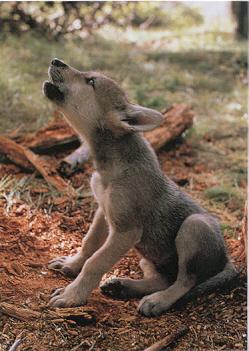Pack
movements and territories
A wolf pack may be territorial or migratory (Chapman,
1978). Mech (1973 cited in Mladenoff, 1995) in part defines wolf packs as subpopulation
units that occupy consistent territories. The range of a traveling wolf pack
depends on the individual wolves, the season, the nature of the country, and
the availability of prey, among multiple other factors. In the spring, a lone
male and a lone female find each other, mate, and produce pups in a den (Rothman
and Mech, 1979 cited in Mech et al., 1998). Pack movements are centered around
the den, but the adults radiate out to hunt and bring back food to the pups.
Usually after a couple of months the pups leave the den and live above ground
at rendezvous sites (Schullery, 1996). Starting in the fall the pups are grown
enough to travel with the adults and the pack moves through its territory.
 The
pack's movement is outlined as two seasonal phases, den-based summer movement
and nomadic winter movement (Mech et al., 1998). Therefore it is essential that
there exist great areas of wild, mountain land for packs to travel and establish
their own territories. Mech (1998) claims "wolves and long travel are almost
synonymous." Wolf pack territories in Minnesota range from 25 square miles to
150 square miles, and in Alaska and Canada territories may be 200 to 1,000 square
miles. The natural tendencies of wolves traveling through grand spaces is very
important as packs are reintroduced to areas with infiltrating human impacts
and increasing land fragmentation.
The
pack's movement is outlined as two seasonal phases, den-based summer movement
and nomadic winter movement (Mech et al., 1998). Therefore it is essential that
there exist great areas of wild, mountain land for packs to travel and establish
their own territories. Mech (1998) claims "wolves and long travel are almost
synonymous." Wolf pack territories in Minnesota range from 25 square miles to
150 square miles, and in Alaska and Canada territories may be 200 to 1,000 square
miles. The natural tendencies of wolves traveling through grand spaces is very
important as packs are reintroduced to areas with infiltrating human impacts
and increasing land fragmentation.
next to Patterns
and trends in dispersal
return to Social
Structure & Dispersal
return home
 The
pack's movement is outlined as two seasonal phases, den-based summer movement
and nomadic winter movement (Mech et al., 1998). Therefore it is essential that
there exist great areas of wild, mountain land for packs to travel and establish
their own territories. Mech (1998) claims "wolves and long travel are almost
synonymous." Wolf pack territories in Minnesota range from 25 square miles to
150 square miles, and in Alaska and Canada territories may be 200 to 1,000 square
miles. The natural tendencies of wolves traveling through grand spaces is very
important as packs are reintroduced to areas with infiltrating human impacts
and increasing land fragmentation.
The
pack's movement is outlined as two seasonal phases, den-based summer movement
and nomadic winter movement (Mech et al., 1998). Therefore it is essential that
there exist great areas of wild, mountain land for packs to travel and establish
their own territories. Mech (1998) claims "wolves and long travel are almost
synonymous." Wolf pack territories in Minnesota range from 25 square miles to
150 square miles, and in Alaska and Canada territories may be 200 to 1,000 square
miles. The natural tendencies of wolves traveling through grand spaces is very
important as packs are reintroduced to areas with infiltrating human impacts
and increasing land fragmentation.